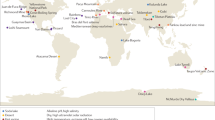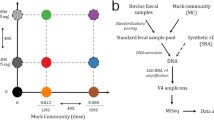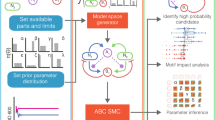Abstract
Molecular microbial community analysis methods have revolutionized our understanding of the diversity and distribution of bacteria, archaea and microbial eukaryotes. The information obtained has adequately demonstrated that the analysis of microbial model systems can provide important insights into ecosystem function and stability. However, the terminology and metrics used in macroecology must be applied cautiously because the methods available to characterize microbial diversity are inherently limited in their ability to detect the many numerically minor constituents of microbial communities. In this review, we focus on the use of indices to quantify the diversity found in microbial communities, and on the methods used to generate the data from which those indices are calculated. Useful conclusions regarding diversity can only be deduced if the properties of the various methods used are well understood. The commonly used diversity metrics differ in the weight they give to organisms that differ in abundance, so understanding the properties of these metrics is essential. In this review, we illustrate important methodological and metric-dependent differences using simulated communities. We conclude that the assessment of richness in complex communities is futile without extensive sampling, and that some diversity indices can be estimated with reasonable accuracy through the analysis of clone libraries, but not from community fingerprint data.
Similar content being viewed by others
Log in or create a free account to read this content
Gain free access to this article, as well as selected content from this journal and more on nature.com
or
References
Abdo Z, Schütte UME, Bent SJ, Williams CJ, Forney LJ, Joyce P . (2006). Statistical methods for characterizing diversity of microbial communities by analysis of terminal restriction fragment length polymorphisms of 16S rRNA genes. Environ Microbiol 8: 929–938.
Baker GC, Smith JJ, Cowan DA . (2003). Review and re-analysis of domain-specific 16S primers. J Microbiol Methods 55: 541–555.
Berger W, Parker FL . (1970). Diversity of planktonic Foraminifera in deep sea sediments. Science 168: 1345–1347.
Crosby LD, Criddle CS . (2003). Understanding bias in microbial community analysis techniques due to rrn operon copy number heterogeneity. Biotechniques 34: 790–794, 796, 798 passim.
Curtis TP, Head IM, Lunn M, Woodcock S, Schloss PD, Sloan WT . (2006). What is the extent of prokaryotic diversity? Philos Trans R Soc Lond B Biol Sci 361: 2023–2037.
Curtis TP, Sloan WT, Scannell JW . (2002). Estimating prokaryotic diversity and its limits. Proc Natl Acad Sci USA 99: 10494–10499.
Curtis TP, Sloan WT . (2004). Prokaryotic diversity and its limits: microbial community structure in nature and implications for microbial ecology. Curr Opin Microbiol 7: 221–226.
Dahllof I . (2002). Molecular community analysis of microbial diversity. Curr Opin Biotechnol 13: 213–217.
DeLong EF, Pace NR . (2001). Environmental diversity of bacteria and archaea. Syst Biol 50: 470–478.
Dunbar J, Barns SM, Ticknor LO, Kuske CR . (2002). Empirical and theoretical bacterial diversity in four Arizona soils. Appl Environ Microbiol 68: 3035–3045.
Dunbar J, Takala S, Barns SM, Davis JA, Kuske CR . (1999). Levels of bacterial community diversity in four arid soils compared by cultivation and 16S rRNA gene cloning. Appl Environ Microbiol 65: 1662–1669.
Dykhuizen DE . (1998). Santa Rosalia revisited: why are there so many species of bacteria? Antonie Van Leeuwenhoek 73: 25–33.
Farrelly V, Rainey FA, Stackebrandt E . (1995). Effect of genome size and rrn gene copy number on PCR amplification of 16S rRNA genes from a mixture of bacterial species. Appl Environ Microbiol 61: 2798–2801.
Frostegard A, Courtois S, Ramisse V, Clerc S, Bernillon D, Le Gall F et al. (1999). Quantification of bias related to the extraction of DNA directly from soils. Appl Environ Microbiol 65: 5409–5420.
Gans J, Wolinsky M, Dunbar J . (2005). Computational improvements reveal great bacterial diversity and high metal toxicity in soil. Science 309: 1387–1390.
Hansen MC, Tolker-Nielsen T, Givskov M, Molin S . (1998). Biased 16S rDNA PCR amplification caused by interference from DNA flanking the template region. FEMS Microbiol Ecol 26: 141–149.
Hartmann M, Widmer F . (2006). Community structure analyses are more sensitive to differences in soil bacterial communities than anonymous diversity indices. Appl Environ Microbiol 72: 7804–7812.
Hewson I, Fuhrman J . (2004). Richness and diversity of bacterioplankton species along an estuarine gradient in Moreton Bay, Australia. Appl Environ Microbiol 70: 3425–3433.
Hill MO . (1973). Diversity and evenness: a unifying notation and its consequences. Ecology 54: 427–432.
Hong SH, Bunge J, Jeon SO, Epstein SS . (2006). Predicting microbial species richness. Proc Natl Acad Sci USA 103: 117–122.
Hughes JB, Hellmann JJ, Ricketts TH, Bohannan BJ . (2001). Counting the uncountable: statistical approaches to estimating microbial diversity. Appl Environ Microbiol 67: 4399–4406.
Hughes RG . (1986). Theories and models of species abundance. Am Nat 128: 897–899.
Jost L . (2006). Entropy and diversity. Oikos 113: 363–375.
Lande R, DeVries PJ, Walla TR . (2000). When species accumulation curves intersect: implications for ranking diversity using small samples. Oikos 89: 601–605.
Liu WT, Marsh TL, Cheng H, Forney LJ . (1997). Characterization of microbial diversity by determining terminal restriction fragment length polymorphisms of genes encoding 16S rRNA. Appl Environ Microbiol 63: 4516–4522.
Loisel P, Harmand J, Zemb O, Latrille E, Lobry C, Delgenes J-P et al. (2006). Denaturing gradient electrophoresis (DGE) and single-strand conformation polymorphism (SSCP) molecular fingerprintings revisited by simulation and used as a tool to measure microbial diversity. Environ Microbiol 8: 720–731.
Louda SM, Rand TA . (2002). Native Thistles: expendable or integral to ecosystem resistance to invasion?. In: Kareiva P and Levin SA (eds). The Importance of Species: Perspectives on Expendability and Triage. Princeton University Press: Princeton NJ. pp 5–15.
Maarit Niemi R, Heiskanen I, Wallenius K, Lindstrom K . (2001). Extraction and purification of DNA in rhizosphere soil samples for PCR-DGGE analysis of bacterial consortia. J Microbiol Methods 45: 155–165.
MacArthur RH . (1960). On the relative abundance of species. Am Nat 94: 25–36.
May RM . (1975). Patterns of species abundance and diversity. In: Diamond JM, Cody ML (eds). Ecology and Evolution of Communities. Belknap Press: Cambridge, MA. pp 81–120.
Nandi S, Maurer JJ, Hofacre C, Summers AO . (2004). Gram-positive bacteria are a major reservoir of Class 1 antibiotic resistance integrons in poultry litter. Proc Natl Acad Sci USA 101: 7118–7122.
Narang R, Dunbar J . (2004). Modeling bacterial species abundance from small community surveys. Microb Ecol 47: 396–406.
Oremland RS, Capone DG, Stolz JF, Fuhrman J . (2005). Whither or wither geomicrobiology in the era of ‘community metagenomics’. Nat Rev Microbiol 3: 572–578.
Osborne CA, Rees GN, Bernstein Y, Janssen PH . (2006). New threshold and confidence estimates for terminal restriction fragment length polymorphism analysis of complex bacterial communities. Appl Environ Microbiol 72: 1270–1278.
Ovreas L, Daae FL, Torsvik V, Rodriguez-Valera F . (2003). Characterization of microbial diversity in hypersaline environments by melting profiles and reassociation kinetics in combination with terminal restriction fragment length polymorphism (T-RFLP). Microb Ecol 46: 291–301.
Phillips CJ, Harris D, Dollhopf SL, Gross KL, Prosser JI, Paul EA . (2000). Effects of agronomic treatments on structure and function of ammonia-oxidizing communities. Appl Environ Microbiol 66: 5410–5418.
Preston FW . (1948). The commonness, and rarity, of species. Ecology 29: 254–283.
Qiu X, Wu L, Huang H, McDonel PE, Palumbo AV, Tiedje JM et al. (2001). Evaluation of PCR-generated chimeras, mutations, and heteroduplexes with 16S rRNA gene-based cloning. Appl Environ Microbiol 67: 880–887.
Reysenbach A, Giver LH, Wickham GS, Pace NR . (1992). Differential amplification of rRNA genes by polymerase chain reaction. Appl Environ Microbiol 58: 3417–3418.
Shannon CE, Weaver W . (1949). The Mathematical Theory of Communication. University of Illinois Press: Urbana, IL.
Simpson EH . (1949). Measurement of diversity. Nature 163: 688.
Soberon J, Llorente J . (1993). The use of species accumulation functions for the prediction of species richness. Conserv Biol 7: 480–488.
Stackebrandt E, Frederiksen W, Garrity GM, Grimont PA, Kampfer P, Maiden MC et al. (2002). Report of the ad hoc committee for the re-evaluation of the species definition in bacteriology. Int J Syst Evol Microbiol 52: 1043–1047.
Staley JT . (2006). The bacterial species dilemma and the genomic-phylogenetic species concept. Philos Trans R Soc Lond B Biol Sci 361: 1899–1909.
Suzuki MT, Giovannoni SJ . (1996). Bias caused by template annealing in the amplification of mixtures of 16S rRNA genes by PCR. Appl Environ Microbiol 62: 625–630.
Tilman D . (1982). Resource Competition and Community Structure. Princeton University Press: Princeton, NJ.
Tokeshi M . (1993). Species abundance patterns and community structure. In: Begon M, Fitter AH (eds). Advances in Ecological Research. Academic Press: London, UK. pp 112–186.
Torsvik V, Daae FL, Sandaa RA, Ovreas L . (1998). Novel techniques for analysing microbial diversity in natural and perturbed environments. J Biotechnol 64: 53–62.
Ward BB . (2002). How many species of prokaryotes are there? Proc Natl Acad Sci USA 99: 10234–10236.
Wellington EM, Berry A, Krsek M . (2003). Resolving functional diversity in relation to microbial community structure in soil: exploiting genomics and stable isotope probing. Curr Opin Microbiol 6: 295–301.
Whitman WB, Coleman DC, Wiebe WJ . (1998). Prokaryotes: the unseen majority. Proc Natl Acad Sci USA 95: 6578–6583.
Wilson JB . (1991). Methods for fitting dominance/diversity curves. J Veg Sci 2: 35–46.
Woese CR . (1987). Bacterial evolution. Microbiol Rev 51: 221–271.
Yachi S, Loreau M . (1999). Biodiversity and ecosystem productivity in a fluctuating environment: the insurance hypothesis. Proc Natl Acad Sci USA 96: 1463–1468.
Zhou J . (2003). Microarrays for bacterial detection and microbial community analysis. Curr Opin Microbiol 6: 288–294.
Zhou X, Brown CJ, Abdo Z, Davis CC, Hansmann MA, Joyce P et al. (2007). Differences in the composition of vaginal microbial communities found in healthy Caucasian and black women. ISME J 1: 121–133.
Acknowledgements
We thank Dr Eva Top, Jacob Pierson and Margaret-Mary McEwen for their critical reviews of this paper and helpful suggestions. This work was supported by an NIH Center of Biomedical Research Excellence grant (PT20 RR 16448) from the National Center for Research Resources to LJJ and SJB was supported by a fellowship from the Subsurface Science Research Initiative of the Inland Northwest Research Alliance.
Author information
Authors and Affiliations
Corresponding author
Rights and permissions
About this article
Cite this article
Bent, S., Forney, L. The tragedy of the uncommon: understanding limitations in the analysis of microbial diversity. ISME J 2, 689–695 (2008). https://doi.org/10.1038/ismej.2008.44
Published:
Issue date:
DOI: https://doi.org/10.1038/ismej.2008.44
Keywords
This article is cited by
-
Differential richness inference for 16S rRNA marker gene surveys
Genome Biology (2022)
-
Seasonal Variability of Conditionally Rare Taxa in the Water Column Bacterioplankton Community of Subtropical Reservoirs in China
Microbial Ecology (2020)
-
Comparison between Allura Red dye discoloration by activated carbon and azo bacteria strain
Environmental Science and Pollution Research (2020)
-
Tools for Analysis of the Microbiome
Digestive Diseases and Sciences (2020)
-
Bacterial community composition and function along spatiotemporal connectivity gradients in the Danube floodplain (Vienna, Austria)
Aquatic Sciences (2020)



